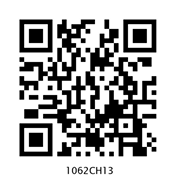Table of Contents
13.1 Introduction
From Class IX, you are familiar with some of the solids like cuboid, cone, cylinder, and sphere (see Fig. 13.1). You have also learnt how to find their surface areas and volumes.

Fig. 13.1
In our day-to-day life, we come across a number of solids made up of combinations of two or more of the basic solids as shown above.
You must have seen a truck with a container fitted on its back (see Fig. 13.2), carrying oil or water from one place to another. Is it in the shape of any of the four basic solids mentioned above? You may guess that it is made of a cylinder with two hemispheres as its ends.
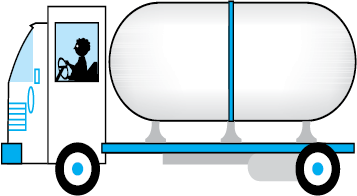
Fig. 13.2
Again, you may have seen an object like the one in Fig. 13.3. Can you name it? A test tube, right! You would have used one in your science laboratory. This tube is also a combination of a cylinder and a hemisphere. Similarly, while travelling, you may have seen some big and beautiful buildings or monuments made up of a combination of solids mentioned above.
If for some reason you wanted to find the surface areas, or volumes, or capacities of such objects, how would you do it? We cannot classify these under any of the solids you have already studied.

Fig. 13.3
In this chapter, you will see how to find surface areas and volumes of such objects.
13.2 Surface Area of a Combination of Solids
Let us consider the container seen in Fig. 13.2. How do we find the surface area of such a solid? Now, whenever we come across a new problem, we first try to see, if we can break it down into smaller problems, we have earlier solved. We can see that this solid is made up of a cylinder with two hemispheres stuck at either end. It would look like what we have in Fig. 13.4, after we put the pieces all together.

Fig. 13.4
If we consider the surface of the newly formed object, we would be able to see only the curved surfaces of the two hemispheres and the curved surface of the cylinder.
So, the total surface area of the new solid is the sum of the curved surface areas of each of the individual parts. This gives,
TSA of new solid = CSA of one hemisphere + CSA of cylinder
+ CSA of other hemisphere
where TSA, CSA stand for ‘Total Surface Area’ and ‘Curved Surface Area’ respectively.
Let us now consider another situation. Suppose we are making a toy by putting together a hemisphere and a cone. Let us see the steps that we would be going through.
First, we would take a cone and a hemisphere and bring their flat faces together. Here, of course, we would take the base radius of the cone equal to the radius of the hemisphere, for the toy is to have a smooth surface. So, the steps would be as shown in Fig. 13.5.

Fig. 13.5
At the end of our trial, we have got ourselves a nice round-bottomed toy. Now if we want to find how much paint we would require to colour the surface of this toy, what would we need to know? We would need to know the surface area of the toy, which consists of the CSA of the hemisphere and the CSA of the cone. So, we can say:
Total surface area of the toy = CSA of hemisphere + CSA of cone
Now, let us consider some examples.
Example 1 :
Rasheed got a playing top (lattu) as his birthday present, which surprisingly had no colour on it. He wanted to colour it with his crayons. The top is shaped like a cone surmounted by a hemisphere (see Fig 13.6). The entire top is 5 cm in height and the diameter of the top is 3.5 cm. Find the area he has to colour. (Take π =  )
)

Fig. 13.6
Solution :
This top is exactly like the object we have discussed in Fig. 13.5. So, we can conveniently use the result we have arrived at there. That is :
TSA of the toy = CSA of hemisphere + CSA of cone
Now, the curved surface area of the hemisphere = 
= 
Also, the height of the cone = height of the top – height (radius) of the hemispherical part
=  = 3.25 cm
= 3.25 cm
So, the slant height of the cone (l ) =  = 3.7 cm (approx.)
= 3.7 cm (approx.)
Therefore, CSA of cone = πrl = 
This gives the surface area of the top as
= 
=  =
= 
You may note that ‘total surface area of the top’ is not the sum of the total surface areas of the cone and hemisphere.
Example 2 :
The decorative block shown in Fig. 13.7 is made of two solids — a cube and a hemisphere. The base of the block is a cube with edge 5 cm, and the hemisphere fixed on the top has a diameter of 4.2 cm. Find the total surface area of the block.
(Take π =  )
)

Fig. 13.7
Solution :
The total surface area of the cube = 6 × (edge)2 = 6 × 5 × 5 cm2 = 150 cm2.
Note that the part of the cube where the hemisphere is attached is not included in the surface area.
So, the surface area of the block = TSA of cube – base area of hemisphere
+ CSA of hemisphere
= 150 – πr2 + 2 πr2 = (150 + πr2) cm2
= 
= (150 + 13.86) cm2 = 163.86 cm2
Example 3 :
A wooden toy rocket is in the shape of a cone mounted on a cylinder, as shown in Fig. 13.8. The height of the entire rocket is 26 cm, while the height of the conical part is 6 cm. The base of the conical portion has a diameter of 5 cm, while the base diameter of the cylindrical portion is 3 cm. If the conical portion is to be painted orange and the cylindrical portion yellow, find the area of the rocket painted with each of these colours. (Take π = 3.14)

Fig. 13.8
Solution :
Denote radius of cone by r, slant height of cone by l, height of cone by h, radius of cylinder by r′ and height of cylinder by h′. Then r = 2.5 cm, h = 6 cm, r′ = 1.5 cm,
h′ = 26 – 6 = 20 cm and
l =  =
=  = 6.5 cm
= 6.5 cm
Here, the conical portion has its circular base resting on the base of the cylinder, but the base of the cone is larger than the base of the cylinder. So, a part of the base of the cone (a ring) is to be painted.
So, the area to be painted orange = CSA of the cone + base area of the cone
– base area of the cylinder
= πrl + πr2 – π(r′)2
= π[(2.5 × 6.5) + (2.5)2 – (1.5)2] cm2
= π[20.25] cm2 = 3.14 × 20.25 cm2
= 63.585 cm2
Now, the area to be painted yellow = CSA of the cylinder
+ area of one base of the cylinder
= 2πr′h′ + π(r′)2
= πr′ (2h′ + r′)
= (3.14 × 1.5) (2 × 20 + 1.5) cm2
= 4.71 × 41.5 cm2
= 195.465 cm2
Example 4 :
Mayank made a bird-bath for his garden in the shape of a cylinder with a hemispherical depression at one end (see Fig. 13.9). The height of the cylinder is 1.45 m and its radius is 30 cm. Find the total surface area of the bird-bath. (Take π = )
)

Fig. 13.9
Solution :
Let h be height of the cylinder, and r the common radius of the cylinder and hemisphere. Then,
the total surface area of the bird-bath = CSA of cylinder + CSA of hemisphere
= 2πrh + 2πr2 = 2πr(h + r)
= 
= 33000 cm2 = 3.3 m2
Exercise 13.1
Unless stated otherwise, take π = 
1. 2 cubes each of volume 64 cm3 are joined end to end. Find the surface area of the resulting cuboid.
2. A vessel is in the form of a hollow hemisphere mounted by a hollow cylinder. The diameter of the hemisphere is 14 cm and the total height of the vessel is 13 cm. Find the inner surface area of the vessel.
3. A toy is in the form of a cone of radius 3.5 cm mounted on a hemisphere of same radius. The total height of the toy is 15.5 cm. Find the total surface area of the toy.
4. A cubical block of side 7 cm is surmounted by a hemisphere. What is the greatest diameter the hemisphere can have? Find the surface area of the solid.
5. A hemispherical depression is cut out from one face of a cubical wooden block such that the diameter l of the hemisphere is equal to the edge of the cube. Determine the surface area of the remaining solid.
6. A medicine capsule is in the shape of a cylinder with two hemispheres stuck to each of its ends (see Fig. 13.10). The length of the entire capsule is 14 mm and the diameter of the capsule is 5 mm. Find its surface area.
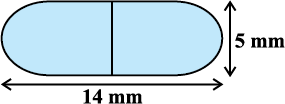
Fig. 13.10
7. A tent is in the shape of a cylinder surmounted by a conical top. If the height and diameter of the cylindrical part are 2.1 m and 4 m respectively, and the slant height of the top is 2.8 m, find the area of the canvas used for making the tent. Also, find the cost of the canvas of the tent at the rate of ` 500 per m2. (Note that the base of the tent will not be covered with canvas.)
8. From a solid cylinder whose height is 2.4 cm and diameter 1.4 cm, a conical cavity of the same height and same diameter is hollowed out. Find the total surface area of the remaining solid to the nearest cm2.
9. A wooden article was made by scooping out a hemisphere from each end of a solid cylinder, as shown in Fig. 13.11. If the height of the cylinder is 10 cm, and its base is of radius 3.5 cm, find the total surface area of the article.
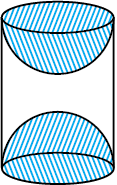
Fig. 13.11
13.3 Volume of a Combination of Solids
In the previous section, we have discussed how to find the surface area of solids made up of a combination of two basic solids. Here, we shall see how to calculate their volumes. It may be noted that in calculating the surface area, we have not added the surface areas of the two constituents, because some part of the surface area disappeared in the process of joining them. However, this will not be the case when we calculate the volume. The volume of the solid formed by joining two basic solids will actually be the sum of the volumes of the constituents, as we see in the examples below.
Example 5 :
Shanta runs an industry in a shed which is in the shape of a cuboid surmounted by a half cylinder (see Fig. 13.12). If the base of the shed is of dimension 7 m × 15 m, and the height of the cuboidal portion is 8 m, find the volume of air that the shed can hold. Further, suppose the machinery in the shed occupies a total space of 300 m3, and there are 20 workers, each of whom occupy about 0.08 m3 space on an average. Then, how much air is in the shed? (Take π =  )
)

Fig. 13.12
Solution :
The volume of air inside the shed (when there are no people or machinery) is given by the volume of air inside the cuboid and inside the half cylinder, taken together.
Now, the length, breadth and height of the cuboid are 15 m, 7 m and 8 m, respectively.
Also, the diameter of the half cylinder is 7 m and its height is 15 m.
So, the required volume = volume of the cuboid +  volume of the cylinder
volume of the cylinder
=  = 1128.75 m3
= 1128.75 m3
Next, the total space occupied by the machinery = 300 m3
And the total space occupied by the workers = 20 × 0.08 m3 = 1.6 m3
Therefore, the volume of the air, when there are machinery and workers
= 1128.75 – (300.00 + 1.60) = 827.15 m3
Example 6 :
A juice seller was serving his customers using glasses as shown in Fig. 13.13. The inner diameter of the cylindrical glass was 5 cm, but the bottom of the glass had a hemispherical raised portion which reduced the capacity of the glass. If the height of a glass was 10 cm, find the apparent capacity of the glass and its actual capacity. (Use π = 3.14.)

Fig. 13.13
Solution :
Since the inner diameter of the glass = 5 cm and height = 10 cm, the apparent capacity of the glass = πr2h
= 3.14 × 2.5 × 2.5 × 10 cm3 = 196.25 cm3
But the actual capacity of the glass is less by the volume of the hemisphere at the base of the glass.
i.e., it is less by  πr3 =
πr3 =  = 32.71 cm3
= 32.71 cm3
So, the actual capacity of the glass = apparent capacity of glass – volume of the hemisphere
= (196.25 – 32.71) cm3
= 163.54 cm3
Example 7 :
A solid toy is in the form of a hemisphere surmounted by a right circular cone. The height of the cone is 2 cm and the diameter of the base is 4 cm. Determine the volume of the toy. If a right circular cylinder circumscribes the toy, find the difference of the volumes of the cylinder and the toy. (Take π = 3.14)
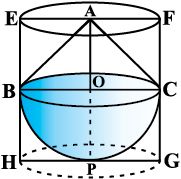
Fig. 13.14
Solution :
Let BPC be the hemisphere and ABC be the cone standing on the base of the hemisphere (see Fig. 13.14). The radius BO of the hemisphere (as well as of the cone) =  × 4 cm = 2 cm.
× 4 cm = 2 cm.
So, volume of the toy = 
=  = 25.12 cm3
= 25.12 cm3
Now, let the right circular cylinder EFGH circumscribe the given solid. The radius of the base of the right circular cylinder = HP = BO = 2 cm, and its height is
EH = AO + OP = (2 + 2) cm = 4 cm
So, the volume required = volume of the right circular cylinder – volume of the toy
= (3.14 × 22 × 4 – 25.12) cm3
= 25.12 cm3
Hence, the required difference of the two volumes = 25.12 cm3.
EXERCISE 13.2
Unless stated otherwise, take π =  .
.
1. A solid is in the shape of a cone standing on a hemisphere with both their radii being equal to 1 cm and the height of the cone is equal to its radius. Find the volume of the solid in terms of π.
2. Rachel, an engineering student, was asked to make a model shaped like a cylinder with two cones attached at its two ends by using a thin aluminium sheet. The diameter of the model is 3 cm and its length is 12 cm. If each cone has a height of 2 cm, find the volume of air contained in the model that Rachel made. (Assume the outer and inner dimensions of the model to be nearly the same.)
3. A gulab jamun, contains sugar syrup up to about 30% of its volume. Find approximately how much syrup would be found in 45 gulab jamuns, each shaped like a cylinder with two hemispherical ends with length 5 cm and diameter 2.8 cm (see Fig. 13.15).
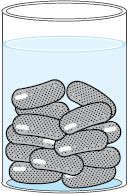
Fig. 13.15
4. A pen stand made of wood is in the shape of a cuboid with four conical depressions to hold pens. The dimensions of the cuboid are 15 cm by 10 cm by 3.5 cm. The radius of each of the depressions is 0.5 cm and the depth is 1.4 cm. Find the volume of wood in the entire stand (see Fig. 13.16).
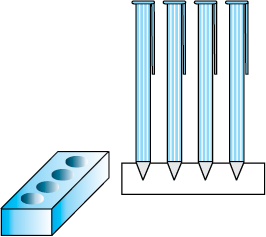
Fig. 13.16
5. A vessel is in the form of an inverted cone. Its height is 8 cm and the radius of its top, which is open, is 5 cm. It is filled with water up to the brim. When lead shots, each of which is a sphere of radius 0.5 cm are dropped into the vessel, one-fourth of the water flows out. Find the number of lead shots dropped in the vessel.
6. A solid iron pole consists of a cylinder of height 220 cm and base diameter 24 cm, which is surmounted by another cylinder of height 60 cm and radius 8 cm. Find the mass of the pole, given that 1 cm3 of iron has approximately 8g mass. (Use π = 3.14)
7. A solid consisting of a right circular cone of height 120 cm and radius 60 cm standing on a hemisphere of radius 60 cm is placed upright in a right circular cylinder full of water such that it touches the bottom. Find the volume of water left in the cylinder, if the radius of the cylinder is 60 cm and its height is 180 cm.
8. A spherical glass vessel has a cylindrical neck 8 cm long, 2 cm in diameter; the diameter of the spherical part is 8.5 cm. By measuring the amount of water it holds, a child finds its volume to be 345 cm3. Check whether she is correct, taking the above as the inside measurements, and π = 3.14.
13.4 Conversion of Solid from one Shape to Another
We are sure you would have seen candles. Generally, they are in the shape of a cylinder. You may have also seen some candles shaped like an animal (see Fig. 13.17).
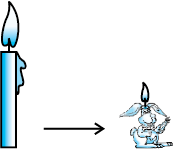
Fig. 13.17
How are they made? If you want a candle of any special shape, you will have to heat the wax in a metal container till it becomes completely liquid. Then you will have to pour it into another container which has the special shape that you want. For example, take a candle in the shape of a solid cylinder, melt it and pour whole of the molten wax into another container shaped like a rabbit. On cooling, you will obtain a candle in the shape of the rabbit. The volume of the new candle will be the same as the volume of the earlier candle. This is what we have to remember when we come across objects which are converted from one shape to another, or when a liquid which originally filled one container of a particular shape is poured into another container of a different shape or size, as you see in Fig 13.18.
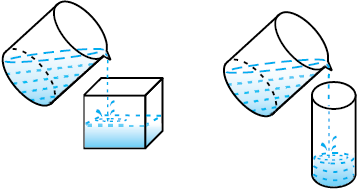
Fig. 13.18
To understand what has been discussed, let us consider some examples.
Example 8:
A cone of height 24 cm and radius of base 6 cm is made up of modelling clay. A child reshapes it in the form of a sphere. Find the radius of the sphere.
Solution :
Volume of cone = 
If r is the radius of the sphere, then its volume is  .
.
Since, the volume of clay in the form of the cone and the sphere remains the same, we have
 =
= 
i.e., r3 = 3 × 3 × 24 = 33 × 23
So, r = 3 × 2 = 6
Therefore, the radius of the sphere is 6 cm.
Example 9 :
Selvi’s house has an overhead tank in the shape of a cylinder. This is filled by pumping water from a sump (an underground tank) which is in the shape of a cuboid. The sump has dimensions 1.57 m × 1.44 m × 95cm. The overhead tank has its radius 60 cm and height 95 cm. Find the height of the water left in the sump after the overhead tank has been completely filled with water from the sump which had been full. Compare the capacity of the tank with that of the sump. (Use π = 3.14)
Solution
: The volume of water in the overhead tank equals the volume of the water removed from the sump.
Now, the volume of water in the overhead tank (cylinder) = πr2h
= 3.14 × 0.6 × 0.6 × 0.95 m3
The volume of water in the sump when full = l × b × h = 1.57 × 1.44 × 0.95 m3
The volume of water left in the sump after filling the tank
= [(1.57 × 1.44 × 0.95) – (3.14 × 0.6 × 0.6 × 0.95)] m3 = (1.57 × 0.6 × 0.6 × 0.95 × 2) m3
So, the height of the water left in the sump = 
= 
= 0.475 m = 47.5 cm
Also,  =
= 
Therefore, the capacity of the tank is half the capacity of the sump.
Example 10 :
A copper rod of diameter 1 cm and length 8 cm is drawn into a wire of length 18 m of uniform thickness. Find the thickness of the wire.
Solution :
The volume of the rod =  .
.
The length of the new wire of the same volume = 18 m = 1800 cm
If r is the radius (in cm) of cross-section of the wire, its volume = π × r2 × 1800 cm3
Therefore, π × r2 × 1800 = 2π
i.e., r2 = 
i.e., r = 
So, the diameter of the cross section, i.e., the thickness of the wire is  cm,
cm,
i.e., 0.67mm (approx.).
Example 11 :
A hemispherical tank full of water is emptied by a pipe at the rate of litres per second. How much time will it take to empty half the tank, if it is 3m in diameter? (Take π =
litres per second. How much time will it take to empty half the tank, if it is 3m in diameter? (Take π = )
)
Solution :
Radius of the hemispherical tank =  m
m
Volume of the tank =  =
= 
So, the volume of the water to be emptied =  =
=  litres
litres
=  litres
litres
Since,  litres of water is emptied in 1 second,
litres of water is emptied in 1 second,  litres of water will be emptied in
litres of water will be emptied in  seconds, i.e., in 16.5 minutes.
seconds, i.e., in 16.5 minutes.
EXERCISE 13.3
Take π =  , unless stated otherwise.
, unless stated otherwise.
1. A metallic sphere of radius 4.2 cm is melted and recast into the shape of a cylinder of radius 6 cm. Find the height of the cylinder.
2. Metallic spheres of radii 6 cm, 8 cm and 10 cm, respectively, are melted to form a single solid sphere. Find the radius of the resulting sphere.
3. A 20 m deep well with diameter 7 m is dug and the earth from digging is evenly spread out to form a platform 22 m by 14 m. Find the height of the platform.
4. A well of diameter 3 m is dug 14 m deep. The earth taken out of it has been spread evenly all around it in the shape of a circular ring of width 4 m to form an embankment. Find the height of the embankment.
5. A container shaped like a right circular cylinder having diameter 12 cm and height 15 cm is full of ice cream. The ice cream is to be filled into cones of height 12 cm and diameter 6 cm, having a hemispherical shape on the top. Find the number of such cones which can be filled with ice cream.
6. How many silver coins, 1.75 cm in diameter and of thickness 2 mm, must be melted to form a cuboid of dimensions 5.5 cm × 10 cm × 3.5 cm?
7. A cylindrical bucket, 32 cm high and with radius of base 18 cm, is filled with sand. This bucket is emptied on the ground and a conical heap of sand is formed. If the height of the conical heap is 24 cm, find the radius and slant height of the heap.
8. Water in a canal, 6 m wide and 1.5 m deep, is flowing with a speed of 10 km/h. How much area will it irrigate in 30 minutes, if 8 cm of standing water is needed?
9. A farmer connects a pipe of internal diameter 20 cm from a canal into a cylindrical tank in her field, which is 10 m in diameter and 2 m deep. If water flows through the pipe at the rate of 3 km/h, in how much time will the tank be filled?
13.5 Frustum of a Cone
In Section 13.2, we observed objects that are formed when two basic solids were joined together. Let us now do something different. We will take a right circular cone and remove a portion of it. There are so many ways in which we can do this. But one particular case that we are interested in is the removal of a smaller right circular cone by cutting the given cone by a plane parallel to its base. You must have observed that the glasses (tumblers), in general, used for drinking water, are of this shape. (see Fig. 13.19)
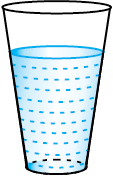
Fig. 13.19
Activity 1 :
Take some clay, or any other such material (like plasticine, etc.) and form a cone. Cut it with a knife parallel to its base. Remove the smaller cone. What are you left with?You are left with a solid called a frustum of the cone. You can see that this has two circular ends with different radii.
So, given a cone, when we slice (or cut) through it with a plane parallel to its base (see Fig. 13.20) and remove the cone that is formed on one side of that plane, the part that is now left over on the other side of the plane is called a frustum* of the cone.
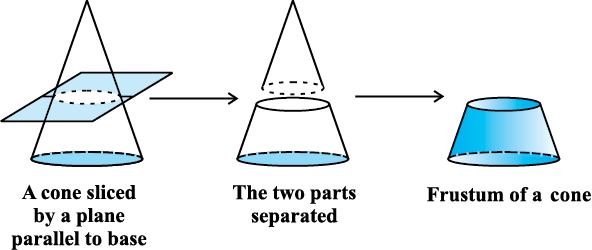
Fig. 13.20
How can we find the surface area and volume of a frustum of a cone? Let us explain it through an example.
Example 12 :
The radii of the ends of a frustum of a cone 45 cm high are 28 cm and 7 cm (see Fig. 13.21). Find its volume, the curved surface area and the total suface area (Take π =  ).
).
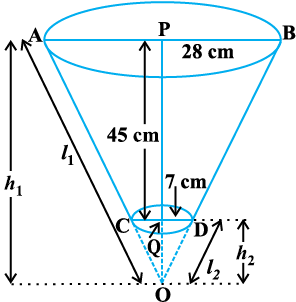
Fig. 13.21
Solution :
The frustum can be viewed as a difference of two right circular cones OAB and OCD (see Fig. 13.21). Let the height (in cm) of the cone OAB be h1 and its slant height l1, i.e., OP = h1 and OA = OB = l1. Let h2 be the height of cone OCD and l2 its slant height.
We have : r1 = 28 cm, r2 = 7 cm
and the height of frustum (h) = 45 cm. Also,
h1 = 45 + h2 (1)
We first need to determine the respective heights h1 and h2 of the cone OAB and OCD.
Since the triangles OPB and OQD are similar (Why?), we have
 =
=  (2)
(2)
From (1) and (2), we get h2 = 15 and h1 = 60.
Now, the volume of the frustum
= volume of the cone OAB – volume of the cone OCD
= 
The respective slant height l2 and l1 of the cones OCD and OAB are given by
l2 = 
l1 = 
Thus, the curved surface area of the frustum = πr1l1 – πr2l2
=  = 5461.5 cm2
= 5461.5 cm2
Now, the total surface area of the frustum
= the curved surface area + 
= 5461.5 cm2 + 
= 5461.5 cm2 + 2464 cm2 + 154 cm2 = 8079.5 cm2.
Let h be the height, l the slant height and r1 and r2 the radii of the ends
(r1 > r2) of the frustum of a cone. Then we can directly find the volume, the curved surace area and the total surface area of frustum by using the formulae given below :
(i) Volume of the frustum of the cone =  .
.
(ii) the curved surface area of the frustum of the cone = π(r1 + r2)l
where l =  .
.
(iii) Total surface area of the frustum of the cone = πl (r1 + r2) + πr12 + πr22,
where l =  .
.
These formulae can be derived using the idea of similarity of triangles but we shall not be doing derivations here.
Let us solve Example 12, using these formulae :
(i) Volume of the frustum = 
=  cm3
cm3
= 48510 cm3
(ii) We have l =  cm
cm
=  = 49.65 cm
= 49.65 cm
So, the curved surface area of the frustum
= π(r1 + r2) l =  = 5461.5 cm2
= 5461.5 cm2
(iii) Total surface area of the frustum
= 
=  cm2 = 8079.5 cm2
cm2 = 8079.5 cm2
Let us apply these formulae in some examples.
Example 13 :
Hanumappa and his wife Gangamma are busy making jaggery out of sugarcane juice. They have processed the sugarcane juice to make the molasses, which is poured into moulds in the shape of a frustum of a cone having the diameters of its two circular faces as 30 cm and 35 cm and the vertical height of the mould is 14 cm (see Fig. 13.22). If each cm3 of molasses has mass about 1.2 g, find the mass of the molasses that can be poured into each mould. 
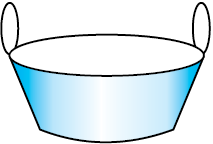
Fig. 13.22
Solution :
Since the mould is in the shape of a frustum of a cone, the quantity (volume) of molasses that can be poured into it =  ,
,
where r1 is the radius of the larger base and r2 is the radius of the smaller base.
=  = 11641.7 cm3.
= 11641.7 cm3.
It is given that 1 cm3 of molasses has mass 1.2g. So, the mass of the molasses that can be poured into each mould = (11641.7 × 1.2) g
= 13970.04 g = 13.97 kg = 14 kg (approx.)
Example 14 :
An open metal bucket is in the shape of a frustum of a cone, mounted on a hollow cylindrical base made of the same metallic sheet (see Fig. 13.23). The diameters of the two circular ends of the bucket are 45 cm and 25 cm, the total vertical height of the bucket is 40 cm and that of the cylindrical base is 6 cm. Find the area of the metallic sheet used to make the bucket, where we do not take into account the handle of the bucket. Also, find the volume of water the bucket can hold.  .
.
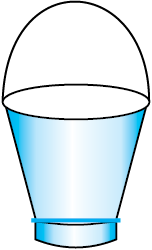
Fig. 13.23
Solution :
The total height of the bucket = 40 cm, which includes the height of the base. So, the height of the frustum of the cone = (40 – 6) cm = 34 cm.
Therefore, the slant height of the frustum, l =  ,
,
where r1 = 22.5 cm, r2 = 12.5 cm and h = 34 cm.
So, l =  cm
cm
= 
The area of metallic sheet used = curved surface area of frustum of cone
+ area of circular base
+ curved surface area of cylinder
= [π × 35.44 (22.5 + 12.5) + π × (12.5)2
+ 2π × 12.5 × 6] cm2
= 
= 4860.9 cm2
Now, the volume of water that the bucket can hold (also, known as the capacity of the bucket)
= 
=  cm3
cm3
=  = 33615.48 cm3
= 33615.48 cm3
= 33.62 litres (approx.)
Exercise 13.4
Use π =  unless stated otherwise.
unless stated otherwise.
1. A drinking glass is in the shape of a frustum of a cone of height 14 cm. The diameters of its two circular ends are 4 cm and 2 cm. Find the capacity of the glass.
2. The slant height of a frustum of a cone is 4 cm and the perimeters (circumference) of its circular ends are 18 cm and 6 cm. Find the curved surface area of the frustum.
3. A fez, the cap used by the Turks, is shaped like the frustum of a cone (see Fig. 13.24). If its radius on the open side is 10 cm, radius at the upper base is 4 cm and its slant height is 15 cm, find the area of material used for making it.
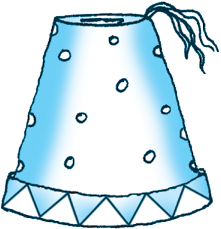
Fig. 13.24
4. A container, opened from the top and made up of a metal sheet, is in the form of a frustum of a cone of height 16 cm with radii of its lower and upper ends as 8 cm and 20 cm, respectively. Find the cost of the milk which can completely fill the container, at the rate of ` 20 per litre. Also find the cost of metal sheet used to make the container, if it costs ` 8 per 100 cm2. (Take π = 3.14)
5. A metallic right circular cone 20 cm high and whose vertical angle is 60° is cut into two parts at the middle of its height by a plane parallel to its base. If the frustum so obtained be drawn into a wire of diameter  find the length of the wire.
find the length of the wire.
Exercise 13.5 (Optional)*
1. A copper wire, 3 mm in diameter, is wound about a cylinder whose length is 12 cm, and diameter 10 cm, so as to cover the curved surface of the cylinder. Find the length and mass of the wire, assuming the density of copper to be 8.88 g per cm3.
2. A right triangle, whose sides are 3 cm and 4 cm (other than hypotenuse) is made to revolve about its hypotenuse. Find the volume and surface area of the double cone so formed. (Choose value of π as found appropriate.)
3. A cistern, internally measuring 150 cm × 120 cm × 110 cm, has 129600 cm3 of water in it. Porous bricks are placed in the water until the cistern is full to the brim. Each brick absorbs one-seventeenth of its own volume of water. How many bricks can be put in without overflowing the water, each brick being 22.5 cm × 7.5 cm × 6.5 cm?
4. In one fortnight of a given month, there was a rainfall of 10 cm in a river valley. If the area of the valley is 7280 km2, show that the total rainfall was approximately equivalent to the addition to the normal water of three rivers each 1072 km long, 75 m wide and 3 m deep.
5. An oil funnel made of tin sheet consists of a 10 cm long cylindrical portion attached to a frustum of a cone. If the total height is 22 cm, diameter of the cylindrical portion is 8 cm and the diameter of the top of the funnel is 18 cm, find the area of the tin sheet required to make the funnel (see Fig. 13.25).
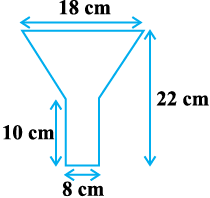
Fig. 13.25
6. Derive the formula for the curved surface area and total surface area of the frustum of a cone, given to you in Section 13.5, using the symbols as explained.
7. Derive the formula for the volume of the frustum of a cone, given to you in Section 13.5, using the symbols as explained.
13.6 Summary
In this chapter, you have studied the following points:
1. To determine the surface area of an object formed by combining any two of the basic solids, namely, cuboid, cone, cylinder, sphere and hemisphere.
2. To find the volume of objects formed by combining any two of a cuboid, cone, cylinder, sphere and hemisphere.
3. Given a right circular cone, which is sliced through by a plane parallel to its base, when the smaller conical portion is removed, the resulting solid is called a Frustum of a Right Circular Cone.
4. The formulae involving the frustum of a cone are:
(i) Volume of a frustum of a cone =  .
.
(ii) Curved surface area of a frustum of a cone = πl(r1 + r2) where l =  .
.
(iii) Total surface area of frustum of a cone = πl(r1 + r2) + π(r12 + r22) where
h = vertical height of the frustum, l = slant height of the frustum
r1 and r2 are radii of the two bases (ends) of the frustum.
* These exercises are not from the examination point of view.
.
